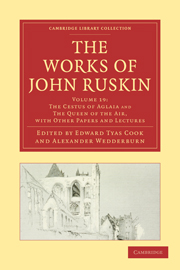Book contents
- Frontmatter
- Contents
- LIST OF ILLUSTRATIONS
- INTRODUCTION TO THIS VOLUME
- PART I “SIR JOSHUA AND HOLBEIN” (1860)
- PART II “THE STUDY OF ARCHITECTURE IN SCHOOLS” (1865)
- PART III “THE CESTUS OF AGLAIA” (1865, 1866)
- PART IV “THE RELATION OF NATIONAL ETHICS TO NATIONAL ARTS,” BEING THE REDE LECTURE FOR 1867
- PART V “ON THE PRESENT STATE OF MODERN ART, WITH REFERENCE TO THE ADVISABLE ARRANGEMENT OF A NATIONAL GALLERY” (1867)
- PART VI “FAIRY STORIES”: A PREFACE TO “GERMAN POPULAR STORIES” (1868)
- PART VII “THE FLAMBOYANT ARCHITECTURE OF THE VALLEY OF THE SOMME” (1869)
- PART VIII “THE QUEEN OF THE AIR” (1869)
- PART IX “VERONA, AND ITS RIVERS” (1870)
- APPENDIX: REPORTS OF ADDRESSES ON ART
- Plate section
PART VII - “THE FLAMBOYANT ARCHITECTURE OF THE VALLEY OF THE SOMME” (1869)
Published online by Cambridge University Press: 05 November 2011
- Frontmatter
- Contents
- LIST OF ILLUSTRATIONS
- INTRODUCTION TO THIS VOLUME
- PART I “SIR JOSHUA AND HOLBEIN” (1860)
- PART II “THE STUDY OF ARCHITECTURE IN SCHOOLS” (1865)
- PART III “THE CESTUS OF AGLAIA” (1865, 1866)
- PART IV “THE RELATION OF NATIONAL ETHICS TO NATIONAL ARTS,” BEING THE REDE LECTURE FOR 1867
- PART V “ON THE PRESENT STATE OF MODERN ART, WITH REFERENCE TO THE ADVISABLE ARRANGEMENT OF A NATIONAL GALLERY” (1867)
- PART VI “FAIRY STORIES”: A PREFACE TO “GERMAN POPULAR STORIES” (1868)
- PART VII “THE FLAMBOYANT ARCHITECTURE OF THE VALLEY OF THE SOMME” (1869)
- PART VIII “THE QUEEN OF THE AIR” (1869)
- PART IX “VERONA, AND ITS RIVERS” (1870)
- APPENDIX: REPORTS OF ADDRESSES ON ART
- Plate section
Summary
1. You stopped at the brow of the hill to put the drag on, and looked up to see where you were:—and there lay beneath you, far as eye could reach on either side, this wonderful valley of the Somme,—with line on line of tufted aspen and tall poplar, making the blue distances more exquisite in bloom by the gleam of their leaves; and in the midst of it, by the glittering of the divided streams of its river, lay the clustered mossy roofs of Abbeville, like a purple flake of cloud, with the precipitous mass of the Cathedral towers rising mountainous through them, and here and there, in the midst of them, spaces of garden close set with pure green trees, bossy and perfect. So you trotted down the hill between bright chalk banks, with a cottage or two nestled into their recesses, and little round children rolling about like apples before the doors, and at the bottom you came into a space of open park ground, divided by stately avenues of chestnut and acacia,—with long banks of outwork and massive walls of bastion seen beyond—then came the hollow thunder of the drawbridge and shadow of the gate—and in an instant, you were in the gay street of a populous yet peaceful city—a fellowship of ancient houses set beside each other, with all the active companionship of business and sociableness of old friends, and yet each with the staid and self-possessed look of country houses surrounded by hereditary fields
- Type
- Chapter
- Information
- The Works of John Ruskin , pp. 241 - 278Publisher: Cambridge University PressPrint publication year: 2010First published in: 1905

